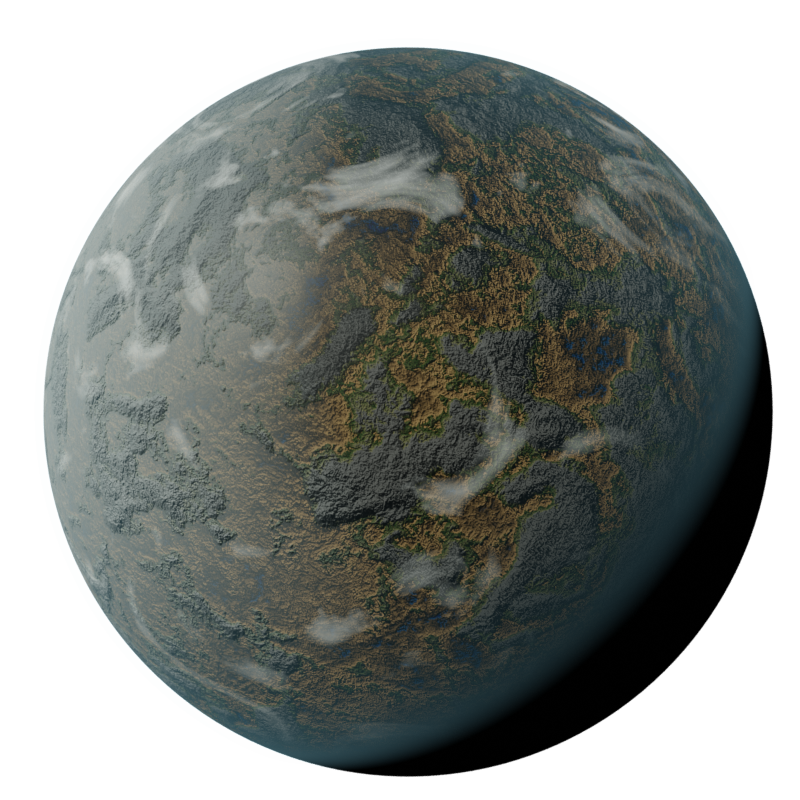
The closest planet to the Abraxas sun, Abraxas I would be unremarkable if not for its unique confluence of astronomy, geology, and ecology. While Abraxas I orbits far enough from its star for a temperate average climate, its rotation perpendicular to the ecliptic means it has no seasons. The small planet’s high rotational speed (its day is only 12.5 standard hours) gives it an unusually pronounced equatorial bulge and causes a significant difference in climates between the poles and equator. Proximity to the Abraxas sun creates a stable convection cycle; as cool polar air heats, it rises toward the upper atmosphere above the equator. This warm air evaporates moisture from a small ocean near the equator and flows outward to cool again, precipitating as polar snow but leaving the rest of the surface mostly arid.
Planetary rotation and the equatorial bulge have underground effects on Abraxas I as well. Although the geology is largely igneous, formed when the planet first cooled, it has a crystalline structure with microscopic lattices that resemble the porous sedimentary rock more common on other planets. This allows Abraxas I’s rotation to draw underground moisture from the polar regions, heated by its proximity to the mantle under the small planet’s thin crust, toward the equator in much the same way as the atmospheric convection currents. Repeated distillation through the atmosphere and filtration through the ground would give Abraxas I a high-quality, purified water supply were it not for the planet’s uniquely evolved flora.
While most of the planet’s moisture remains underground until it reaches caves near the equator, some escapes to the surface through fissures in Abraxas I’s mountainous regions, allowing millennia of erosion to create soil and, eventually, plant life. Because Abraxas I has no seasons, its flora did not evolve starches to store energy for winter. Instead, consistent photosynthesis allows them to exclusively produce sugars for immediately available energy. This more efficient process also releases a higher volume of oxygen as its waste byproduct, giving Abraxas I a somewhat richer atmosphere than normal for a planet of its size.
While Abraxas I’s flora is sparse, dependent on limited water in the mountains, it flourishes in a verdant equatorial swamp where water flows freely from caves toward the planet’s only ocean. In this intermediate region, lush vegetation grows directly in standing water. Tidal exchange allows this hot, sugary swamp water to backflow to the nearby caves, where a robust mycology of fungi breaks down dead plant matter, converting sugars into alcohol and carbon dioxide. Thus, the fluid which reaches the ocean is a heavily fermented mash. Further climate-driven distillation removes excess water, leaving behind a substance with high alcohol content. Although the ocean’s chemistry prevents complex evolution, it also purifies any bacterial contamination even when introduced by an external source. The ocean is thus readily potable – though many species find it extremely intoxicating.
Although Abraxas I has no indigenous sentient species, it has attracted a moderate population, most of whom work in industries connected to the planet’s unique natural beverage. A number of firms pass it through additional filters or age it in barrels intended to impart particular flavors, while many taverns and pubs draw it directly from the ocean to their taps. Hospitality is also an important industry as cheap liquor has made the planet a popular resort destination, and some spas even offer baths and feather, fur, or scale treatments for species who benefit more from external application than from consumption.
- Name: Abraxas I (14, 10)
- Sector: Yushan
- System: Abraxas (-43, -291)
- Type: Temperate/breathable
- Size: 7x7
- Government: Czerka Corporation
- Governor: Czerka Corporation
- Magistrate: Ling Reen
- Tax Level: 5.0000%
- Total: 44,794,020 inhabitants
- Hireable Population: 1,000
- Civilization: 13.7400%
- Ground Combat: PvE
- Bandits & Creatures: Hostile













